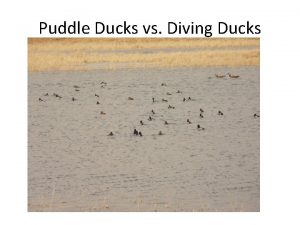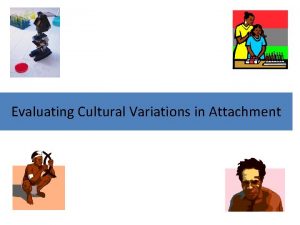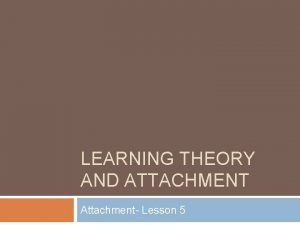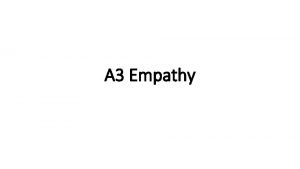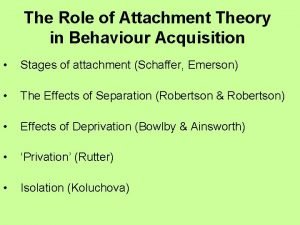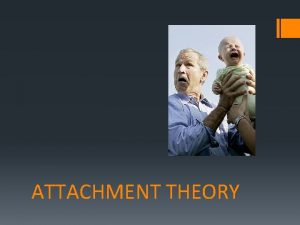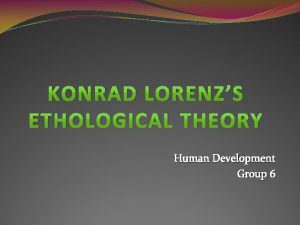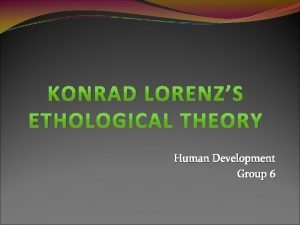Attachment Theory and Cultural Difference ATTACHMENT Lorenzs Ducks








- Slides: 8

Attachment Theory and Cultural Difference

ATTACHMENT • Lorenz’s Ducks Lorenz Ducks • Harlow’s Monkeys • Harlow's Monkeys

ATTACHMENT THEORY John Bowlby (1969) British Psychoanalytical Researcher. Assumption: Human infants need to feel secure and without that a child will develop J A 'abnormally', or exhibit fear, mistrust and even avoidance in later relationships. -Theory: - - Infant stays close to attached caregiver (proximity seeking) in situation of perceived stress or alarm for survival. -Important period for attachment is 6 months to 2 years of age. - -Quality of attachment was based mainly on how sensitive (good at judging what the child needs) and responsive (quick to assist or sooth the child) the mother was. -These attachments lead to 'internal working models' which relate to how they relate throughout their lives. -'Secure base' most important for psychological development -

Stranger Situation Classification (SCC) Mary Ainsworth (1978) SECURE They cry when mother leaves and are happy and move toward her when she returns. INSECURE-AVOIDANT: Show little or no interaction with the mother when present, or when she leaves or returns. When picked up they may want to get down. INSECURE RESISTANT-AMBIVALENT: Less likely to explore toys when mom present and show greater distress when she leaves the room. When she returns they show ambivalence, running to her but then pushing her away when she attempts to comfort them. DISORGANIZED/DISORIENTED Unusual behavior. Seem dazed and detached when mother leaves the room but with outbursts of anger and when the mother returns they are fearful. Some freeze their movements in odd postures. Shows up in children with down's syndrome or autism. Possibly fetal alcohol or drug syndrome.

The Strange Situation https: //www. youtube. com/watch? v=QTsew. Nr. HUH U

US Study: Mary Ainsworth (1978) U. S. children: a. Secure (B) (50%-60%) b. Insecure-avoidant (A) (15%) c. Insecure- resistant (C) (15%) d. Disorganized (10%) (D)

CROSS CULTURAL COMPARISON Van Ijzendoorn MH and Kroonenberg PM (1988): 'Strange-Situation' Country Studies Secure: Type B Anxious Avoidant Type A Anxious-Resistant Type C Parenting Style West Germany 3 57. 00% 35. 00% 8. 00% Independence highly valued Great Britain 1 75. 00% 22. 00% 3. 00% Netherlands 4 67. 00% 26. 00% 7. 00% Sweden 1 74. 00% 22. 00% 4. 00% Israel 2 64. 00% 7. 00% 29. 00% Communal care in Kibbutz Japan 2 68. 00% 5. 00% 27. 00% Mother and child rarely separated China 1 50. 00% 25. 00% United States 18 65. 00% 21. 00% 14. 00% Close contact

GENERAL CONCLUSIONS. Attachment types in Stranger Situation tend to apply universally with variations particularly in non-secure attachment styles. . Variations reflect different cultural values and parenting styles. . Greater intra-cultural difference than inter-cultural. . Stranger Situation classification styles are inconclusive in predictive strength. The only type that appears to have consistent predictive strength is the disorganized type. . Need for more Non-Western studies. . Need to develop new forms of measurements and more controlled longitudinal studies to assess predictive usefulness.
 Puddle ducks vs divers
Puddle ducks vs divers Knapp's relational model
Knapp's relational model Cultural variations in attachment
Cultural variations in attachment Outline and evaluate the learning theory of attachment
Outline and evaluate the learning theory of attachment Robert vischer empathy theory advantages
Robert vischer empathy theory advantages Schaffer and emerson
Schaffer and emerson Neoclassical organization theory
Neoclassical organization theory Molecular orbital theory and valence bond theory
Molecular orbital theory and valence bond theory Which of the following is a theory x assumption?
Which of the following is a theory x assumption?
